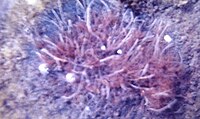Tubifex tubifex: Difference between revisions
BOT--Reverting link addition(s) by Studiomacleod to revision 311195743 (http://www.youtube.com/watch?v=TcKpx2DxGwY) |
sewer blob controversy added |
||
| Line 16: | Line 16: | ||
The worms can survive with little [[oxygen]] by waving [[hemoglobin]] rich tail-ends to exploit all available oxygen. They can also survive in areas heavily [[pollution|polluted]] with organic matter that almost no other species can endure. By forming a protective cyst and lowering its [[metabolic rate]], ''T. tubifex'' can survive drought and food shortage. Encystment may also function in the dispersal of the worm. |
The worms can survive with little [[oxygen]] by waving [[hemoglobin]] rich tail-ends to exploit all available oxygen. They can also survive in areas heavily [[pollution|polluted]] with organic matter that almost no other species can endure. By forming a protective cyst and lowering its [[metabolic rate]], ''T. tubifex'' can survive drought and food shortage. Encystment may also function in the dispersal of the worm. |
||
===Controversy=== |
|||
Tubifex worms have become an subject on controversy, regarding the viral video "Unknown Lifeform in North Carolina Sewer" [http://www.youtube.com/watch?v=TcKpx2DxGwY] that in summer of 2009 received over 7 million views. The theory most credited with explaining the creature is that it is a colony of tubifex worms. This comes in contrast to the statements issued by Ryan MacLeod Morris, editor of www.uforadar.com, who believes that the mystery blob is an alien lifeform. The controversy has garnered significant media attention, being covered by ABC news, Aftonbladet Sweden, and the American morning radio host Mancow. |
|||
=== Links === |
=== Links === |
||
* [http://www.youtube.com/watch?v=88tjjMGZXYg Tubifex video on YouTube] |
* [http://www.youtube.com/watch?v=88tjjMGZXYg Tubifex video on YouTube] |
||
Revision as of 19:20, 7 September 2009
| Tubifex tubifex | |
|---|---|

| |
| Scientific classification | |
| Kingdom: | |
| Phylum: | |
| Class: | |
| Order: | |
| Family: | |
| Genus: | |
| Species: | T. tubifex
|
| Binomial name | |
| Tubifex tubifex (Müller, 1774)
| |

Tubifex tubifex, also called the sludge worm, or sewage worm, is a species of tubificid segmented worm that inhabits the sediments of lakes and rivers on several continents. Tubifex probably includes several species, but distinguishing between them is difficult because the reproductive organs, commonly used in species identification, are resorbed after mating, and because the external characteristics of the worm vary with changes in salinity. These worms ingest sediments, selectively digest bacteria, and absorb molecules through the body wall.
The worms can survive with little oxygen by waving hemoglobin rich tail-ends to exploit all available oxygen. They can also survive in areas heavily polluted with organic matter that almost no other species can endure. By forming a protective cyst and lowering its metabolic rate, T. tubifex can survive drought and food shortage. Encystment may also function in the dispersal of the worm.
Controversy
Tubifex worms have become an subject on controversy, regarding the viral video "Unknown Lifeform in North Carolina Sewer" [1] that in summer of 2009 received over 7 million views. The theory most credited with explaining the creature is that it is a colony of tubifex worms. This comes in contrast to the statements issued by Ryan MacLeod Morris, editor of www.uforadar.com, who believes that the mystery blob is an alien lifeform. The controversy has garnered significant media attention, being covered by ABC news, Aftonbladet Sweden, and the American morning radio host Mancow.
